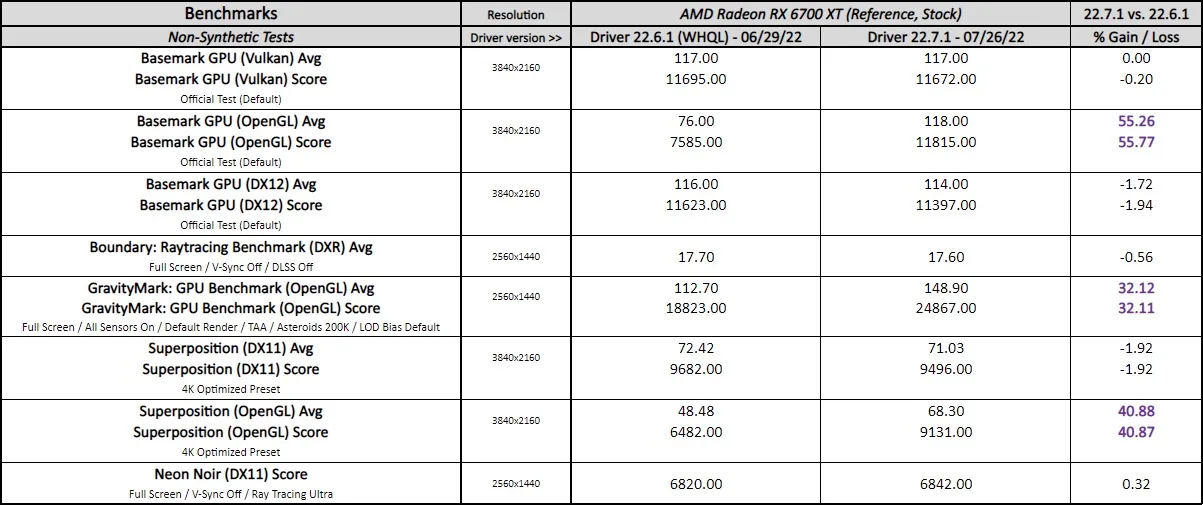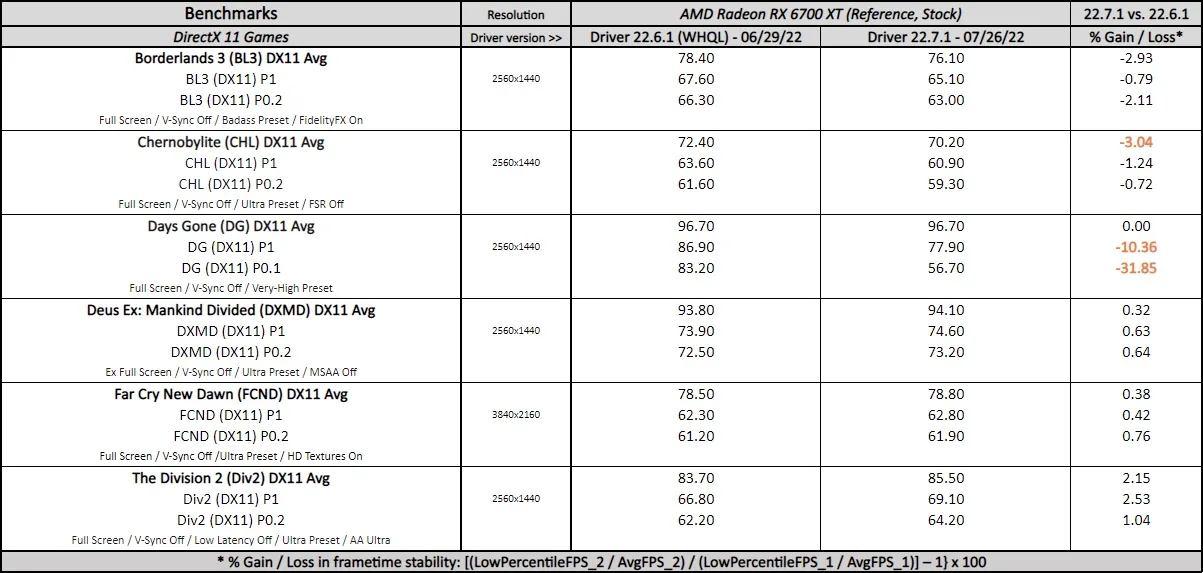Adrenalin 22.7.1 Driver Performance Analysis – 22.7.1 vs. 22.6.1 – 17 games benchmarked using the RX 6700 XT
This review showcases the latest reference Radeon RX 6700 XT’s Adrenalin driver performance with 17 PC games. We benchmark the Optional Adrenalin 22.7.1 driver released a few days ago versus our previously recommended driver 22.6.1. We perform all tests using the same game version and OS build.
This latest Radeon Software Adrenalin 22.7.1 Optional driver was released on July 26 primarily to introduce new AMD Noise Suppression technology, expanded hardware support for Radeon Super Resolution upscaling technology, OpenGL performance optimization, and other enhancements.

Our testing platform is a recent Windows 11 64-bit Pro Edition installation, an i9-12900K with stock clocks, an ASUS PRIME Z690-P D4 motherboard, and 32GB of T-FORCE XTREEM ARGB WHITE DDR4 3600MHz. The games tested, settings, and hardware, are identical except for the drivers we compare.
Benching Methodology
Test Configuration – Hardware
- 12th Gen Intel Core i9-12900K (Hyper-Threading/Turbo boost on; stock settings)
- ASUS PRIME Z690-P D4 motherboard (Intel Z690 chipset, v.1008 BIOS)
- T-FORCE XTREEM ARGB WHITE 32GB DDR4 (2×16GB, dual-channel at 3600 MHz CL14 XMP), supplied by TeamGroup
- AMD Radeon RX 6700 XT (Reference) 12GB, stock clocks, on loan from AMD
- 1 x Samsung 500GB SSD 960 EVO NVMe M.2
- 2 x WD Blue 1TB SATA SSD
- 1 x TeamGroup MP33 M.2 PCIe 1TB SSD
- Corsair RM850x, 850W 80PLUS Gold power supply unit
- ASUS TUF Gaming VG289Q 28? IPS UltraHD (3840×2160) 60Hz 5ms FreeSync Monitor for testing games at 2160p resolution.
- ASUS ROG Swift PG279Q 27? IPS QuadHD (2560 x 1440) 165Hz 4ms G-Sync Monitor for testing games at 1440p resolution.
Test Configuration – Software
- AMD Software Adrenalin 22.7.1 drivers, and 22.6.1 drivers; default AMD Radeon features and settings; AMD FreeSync ‘Disabled’ (when applicable).
- AMD SAM/Resizable BAR On
- V-Sync ‘off, unless application specifies’ in the Software Adrenalin control center; V-Sync off in-game.
- AA and AF as noted in games; all in-game settings are specified.
- Windows 11 64-bit Pro edition, latest updates v21H2; High-performance power plan; Game Mode, Game DVR & Game Bar features off; Control Flow Guard (CFG) off on a per-game basis; Hypervisor and Virtualization-based security are disabled.
- We do not install GIGABYTE and ASUS tools.
- Latest DirectX
- All 17 games are patched to their latest versions at the time of publication.
- 3DMark’s suite and UNIGINE Superposition benchmark, the latest version
- Basemark GPU benchmark, v.1.2.3
- UNIGINE Superposition, v.1.1
- CapFrameX (CX), the latest version
- RivaTuner Statistics Server (RTSS), the latest version
- Display Driver Uninstaller (DDU), the latest version; always uninstall old driver using DDU in safe mode, clean, and restart.
-
ISLC (Purge Standby List) before each benchmark.
Radeon Software Adrenalin Suite-related
- The minimal Radeon Adrenalin Software installation is used.
- We install the display driver.
- We enable the ‘Issue detection’ setting.
Hybrid & Non-Synthetic Tests-related
- Single run per test.
Game Benchmarks-related
- The corresponding built-in or custom benchmark sequence is used.
Frametimes Capture & Analysis tool-related
- We use CapFrameX for capturing and analyzing the relevant performance numbers obtained from each recorded built-in or custom benchmark sequence.
- We always perform consecutive runs until detecting 3 valid runs (no outliers) that we can aggregate using CapFrameX and the following method:
- ‘Aggregate excluding outliers’:
- Outlier metric: Third, P0.2 (0.2% FPS percentile).
- Outlier percentage: 3% (the % the FPS of an entry can differ from the median of all entries before counting as an outlier).
- ‘Aggregate excluding outliers’:
- We compare and evaluate the results and aggregated records in terms of percentages of gain/loss and set the following thresholds to consider a % value as significant (not within the margin of error) for our benchmarking purposes:
- Score/FPS Avg > 3% when valuing hybrid and non-synthetic benchmarks;
- FPS Avg > 3% when evaluating raw performance;
- P1/P0.2 > 3% when evaluating frame time consistency; after applying our custom formula
{[(LowPercentileFPS_2 / AvgFPS_2) / (LowPercentileFPS_1 / AvgFPS_1)] – 1} x 100
Benchmark Suite: 17 PC Games, 4 Hybrid & 5 Non-Synthetic Tests
Hybrid Tests (3DMark)
- DirectX Raytracing feature test (DXR)
- Fire Strike Extreme (DX11)
- Port Royal (DXR)
- Time Spy (DX12)
Non-Synthetic Tests
- Basemark GPU (Vulkan, OpenGL, DX12)
- Boundary: Raytracing Benchmark (DXR)
- Gravity Mark: GPU Benchmark (OpenGL) – NEW
- Neon Noir (Benchmark, DX11)
- UNIGINE Superposition (DX11, OpenGL)
DX11 Games
- Borderlands 3 (DX11)
- Chernobylite (DX11)
- Days Gone (DX11)
- Deus Ex: Mankind Divided (DX11)
- Far Cry New Dawn (DX11)
- Tom Clancy’s The Division 2 (DX11)
DX12 Games
- Cyberpunk 2077 (DX12)
- DIRT 5 (DX12)
- F1 2021 (DX12)
- Far Cry 6 (DX12)
- Horizon Zero Dawn (DX12)
- Metro Exodus PC Enhanced Edition (DX12)
- Shadow of the Tomb Raider (DX12)
- Watch Dogs: Legion (DX12)
Vulkan Games
- DOOM Eternal (VK)
- Quake 2 RTX (VK; v.1.5.0)
- Wolfenstein Youngblood (VK)
AMD Software Adrenalin Control Center Settings
Here are the global Adrenalin Control Center settings:

All the AMD Radeon Software Adrenalin features and settings are default.
AMD Radeon Software Adrenalin 22.7.1
The Radeon Software Adrenalin 22.7.1 Optional driver was released on July 26 primarily to introduce new AMD Noise Suppression technology, expanded hardware support for Radeon Super Resolution upscaling, and OpenGL performance optimization, and other enhancements.
The download links for the Adrenalin 22.7.1 Optional drivers can be found starting here. The 22.7.1 release notes can be found here.
Here are the release highlights of Adrenalin v22.7.1 from AMD Radeon’s website:
-
-
- Swordsman Remake.
- Radeon Boost using Variable Rate Shading with Elden Ring, Resident Evil Village, and VALORANT.
- Microsoft Windows 11 version 22H2.
- Microsoft Agility SDK Release 1.602 including new minor features.
- Microsoft Agility SDK Release 1.606 including Microsoft Shader Model 6.7.
- Additional Vulkan extensions. Click here for more information.
- AMD Noise Suppression
- Our newest feature: AMD Noise Suppression reduces background audio noise from your surrounding environment using a real-time deep learning algorithm, providing greater clarity and improved concentration whether you are focused on an important meeting or staying locked in on a competitive game. To learn more, check out our blog post HERE!
- OpenGL Optimizations
- Up to 79% increase in performance in Minecraft @ 4k Fabulous settings, using Radeon Software Adrenalin 22.7.1 on the Radeon RX 6950XT, versus the previous software driver version 22.6.1.
- Up to 75% increase in performance in Minecraft @ 4k Fabulous settings, using Radeon Software Adrenalin 22.7.1 on the Radeon RX 6400, versus the previous software driver version 22.6.1.
- Radeon Super Resolution
- Expanded support for discrete Radeon RX 5000 and 6000 series GPUs on AMD Ryzen processor notebooks with hybrid graphics.
- RSR has been improved to provide a more seamless experience in borderless fullscreen mode with a performance/quality slider to personalize your gaming experience.
-
Fixed Issues
-
-
-
- Lower than expected Folding@home compute performance with OpenCL API on some AMD Graphics Products such as the Radeon RX 6800.
- Auto Undervolt may disable the Zero RPM fan feature.
- Hitman 3 may freeze when rapidly switching between windows in Fullscreen Exclusive mode.
- Video upscaling in browsers appears blurry with some AMD Graphics Products such as the Radeon RX 6900 XT Graphics.
- Enhanced Sync may cause games to lock to 15FPS with video playback on extended monitors.
-
-
The Adrenalin 22.7.1 Driver Performance – Summary Charts with 17 Games
Below you can find the summary charts of our representative selection of 17 games plus 4 hybrid and 5 non-synthetic benchmarks. We chart our games’ driver performance progression from version 22.6.1 to 22.7.1 using the reference AMD Radeon RX 6700 XT.
You can see the list of graphics settings on the charts, and we run each built-in or custom game benchmark’s sequence at 2560×1440, except for Far Cry New Dawn, tested at 3840×2160 resolution; and Metro Exodus PC Enhanced Edition (DXR) and Quake 2 RTX (Vulkan Ray Tracing Pipeline) which are tested at 1920×1080 resolution.
Results give average framerates and higher is better. We display the low FPS percentiles (P1 and P0.2) below the corresponding averages. We use CapFrameX to record frametimes over time and to visualize and convert them into their corresponding average FPS and P1 and P0.2 FPS percentiles values.
There are also columns showing percentages of gain/loss in both raw performance (average FPS) and, when applicable, in frametimes consistency or stability between the different driver versions. We applied the following custom formula to calculate the stability gains or losses:
{[(LowPercentileFPS_2 / AvgFPS_2) / (LowPercentileFPS_1 / AvgFPS_1)] – 1} x 100
We mark significant performance changes (higher than 3%) in bold and use purple for the significant improvements or orange font for regressions.
Ad renalin 22.7.1 Driver Performance Charts







Notes on Adrenalin 22.7.1 Driver Performance – 22.7.1 vs. 22.6.1
From the charts, although we see no significant differences in graphics performance between drivers for the hybrid tests, we see notable performance improvements in Basemark GPU (OpenGL), Gravity Mark: GPU Benchmark (OpenGL), and Superposition (OpenGL) non-synthetic tests.
For the game benchmarks, although many games show no significant differences when we upgrade to the 22.7.1 drivers from 22.6.1, we see significant improvements in Cyberpunk 2077 (DXR), Far Cry 6 (DX12 & DXR), Horizon Zero Dawn (DX12), Metro Exodus PC Enhanced Edition (DXR), and Watch Dogs: Legion (DX12) in terms of raw performance; Cyberpunk 2077 (DX12 & DXR) and DOOM Eternal (Vulkan Ray Pipeline) in terms of frametime consistency; but also noteworthy performance regressions in Chernobylite (DX11) and DOOM Eternal (Vulkan and Vulkan Ray Pipeline) in terms of raw performance, Days Gone (DX11), Far Cry 6 (DXR), Metro Exodus PC Enhanced Edition (DXR), and Watch Dogs Legion (DX12) in terms of frametime stability.
The noticeable regression in terms of frame time consistency in Days Gone (DX11) with 22.7.1 results in micro-stuttering during gameplay, and The Division 2 (DX11) still shows noticeable hitching and random crashes during gameplay. However, the annoying stuttering we saw in DOOM Eternal (Vulkan Ray Pipeline) with driver 22.6.1 is not present using the latest 22.7.1 drivers.
Disclaimer
Please be aware that the following results, notes, and the corresponding driver recommendation are valid for similar RDNA 2.0 gaming rigs on Windows 11 v21H2. Its representativeness, applicability, and usefulness on different AMD Radeon micro-architectures, testing benches, and Microsoft Windows versions may vary.
Conclusion
The performance of the latest AMD Software Adrenalin 22.7.1 driver was like a roller coaster. Based on our previous results and findings, although we saw some significant and notable performance gains using the latest 22.7.1 driver compared to 22.6.1 drivers, we still see significant performance inconsistencies and notable performance regressions that prevent us from recommending 22.7.1 for general or global use for Radeon users. Therefore, our current recommended driver for RDNA 2.0 gamers is still the Adrenalin 22.6.1 Optional driver or WHQL AMD’s Recommended 22.5.1 drivers for the best functional stability.
Since the Adrenalin 22.7.1 driver can bring notable performance gains in OpenGL games and applications, and in certain DX12 or Vulkan games, we recommend doing your own testing to see how the Adrenalin 22.7.1 Optional driver works with your gaming rig and set of favorite games.
Some qualitative reasons may make it advisable to upgrade to version 22.7.1. These reasons include higher-level driver bug fixes, optimized support for Swordsman Remake and Windows 11 22H2, and support for the latest AMD Radeon technologies, such as AMD Noise Suppression.
Let’s Play!
***
Rodrigo González (aka “RodroG”) is an enthusiast gamer and tech reviewer interested especially in shooter games, open-world role-playing games, and software and hardware benchmarking. He is the author of the NVIDIA WHQL Driver Performance Benchmarks Series and founder and moderator of the r/allbenchmarks community on Reddit.
*The featured image is from AMD.
Comments are closed.